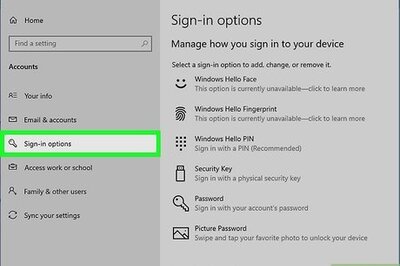
views
X
Research source
Determine your vocal range, follow the director’s instructions, listen to the singers around you, and use proper breathing and posture techniques to get the most out of your choir experience.
Joining a Choir

Determine which part you can sing. Choir music is divided into four basic parts: Soprano (C4 to C6), Alto (G3 to F5), Tenor (D3 to A4), and Bass (E2 to E4). Test out your vocal range by playing the notes in those ranges on a piano and sing along to see which part is most comfortable. Classical voice types are further categorized into parts like Mezzo Soprano, Contralto, and Baritone. If you join a beginners' choir, the director may be able to help you determine which part you can sing.

Select and join a choir. Select the kind of choir would best suit you depending on your age, your level of experience, the type of music you like to sing, and how much time you are able to commit. World music groups (or natural voice choirs), community choirs, and church choirs tend to be more informal and don't usually require auditions. Contemporary or classical choirs, gospel choirs, barbershop choirs, and a cappella groups are more advanced and are likely to require auditions. Children's choirs are a great option for younger singers whose voices don't blend in as well with adult voices. The directing style will also be geared toward children to help them learn and have fun.

Nail your audition. For some choirs, you may be able to join right away, but for others, you will need to audition. If the director gives you a piece to audition with, find your part and practice it until you feel comfortable. If you're allowed to choose your own piece, find one that suits your vocal range and practice it well for your audition. Select a song within the genre that the choir typically sings. The director may ask you to do some vocal exercises or scales to test your control and range. They may also want you to demonstrate your sightreading skills and pitch memory.

Pay membership fees. Most choirs require fees to cover the cost of sheet music, travel (if the choir tours), and uniforms (if the choir requires them). However, every choir is different and there may be additional costs to cover. Some choirs require formal wear for performances. The director may allow the choir to choose their own clothing as long as it fits the requirements, or they may require members to purchase identical formal wear through the same company, which will cost extra. These dues are generally paid annually and are typically pretty reasonable. If you can't afford the fee, talk to the director to see if they are able to offer you a scholarship or waive the fee.
Practicing and Improving
Arrive at each practice early and be prepared. Aim to show up 10 minutes before the session starts. Directors typically expect choir members to be seated, have their music on hand, and be ready to begin at the beginning of each rehearsal. If you aren't given a folder to hold your sheet music, use a black binder. When looking at the music while singing, hold it high up so you aren't tilting your chin down, but don't allow it to block your sound or your view of the director.

Follow the director’s instructions. Your director will lead you through warm-ups, practices, and performances. It’s important to pay close attention to your director and learn from their teaching—they are there to help you improve as an individual and as a group.

Warm up correctly. Your director will lead you through some vocal exercises to warm up your voice before beginning practice. When participating in these exercises, make sure to warm up your voice gently and safely to keep your voice from straining. Always take a big, deep breath before you start. Try yawning—this opens your throat and makes your voice resonate.

Learn musical terms and how to read music. You will likely learn this as you go, but having a basic understanding of how to read music will help you immensely, particularly with sight-reading. Along with studying the notes and rhythms, review musical terms used in choral music. These terms, such as sotto voce (which means to sing softly) and staccato (which means to make your pronunciation short and snappy), will indicate the volume and attitude with which you should sing the words.

Mark your music. If you’re allowed to, make notes on your music to help you improve. Circle the dynamics or sections that you tend to miss, along with tempo or key changes. If it is difficult to find your part in complicated sections, you could mark your part with an asterisk to find it more easily. Generally, choral music is loaned to the choir members, so after you have determined whether or not you’re allowed to make marks, be sure to use a pencil so the marks can be easily erased.

Practice often. Along with attending practices, you should regularly practice on your own. Take time to master any difficult sections and improve your part. If everyone in the choir does this, the group as a whole will learn and improve much faster.
Blend your voice with the singers around you. Pay attention to the volume, tone, and balance of the rest of the choir to help you blend your voice with the others’, match their timing, and sound better as a unit. Ensure your enunciation is similar to the other choir members' as well.
Breathing and Posture

Use controlled breathing. This will allow you to hold notes longer and make your voice even stronger. When you sing, breathe from the diaphragm and let the air flow evenly. To improve your breathing, try this exercise: Take a deep, controlled breath and sing “ah” for as long as you can while you let the air out evenly. Do this every day for several weeks and you will see improvement in your singing. Use your breathing to increase your volume. Rather than open your mouth wider, increase the controlled amount of air you push out.

Sit forward. If you’re asked to sit, sit comfortably upright but don’t let your back touch the chair. Keep your body tall and straight in line over your hips. Keep your shoulders down and back and your arms relaxed. Your feet should be on the ground and slightly apart, and the weight of your body should be leaning forward.

Stand up straight. The better your posture, the better the sound you will produce. Depending on your director’s choice, you may be sitting or standing, so it’s important to learn correct choral posture for both. Good posture is also proven to improve your attention and mood, which will help you stay engaged in practices and performances. If you’re asked to stand, stand up straight with your shoulders back to open your lungs. Keep your chin parallel to the floor, shoulders back, abdomen loose to allow for deep inhales, and hands relaxed at your sides (unless you're holding sheet music). Just as with sitting posture, your feet should be slightly apart and the weight of your body should be leaning slightly forward. Don’t lock your knees—instead, keep them flexible and loose.




















Comments
0 comment